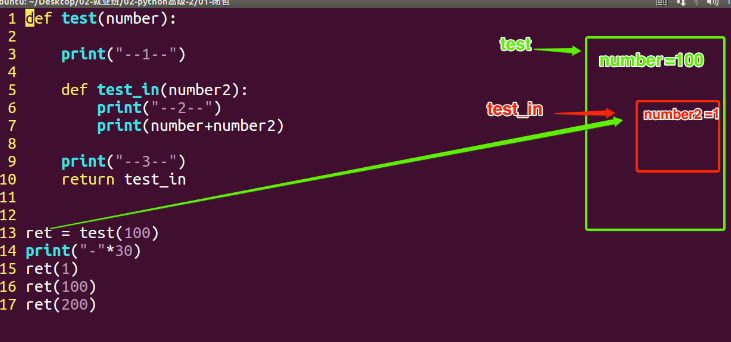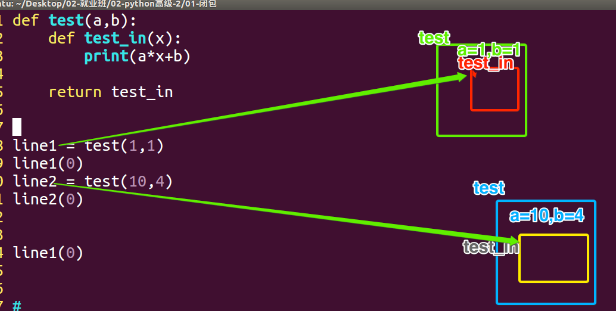1. 函数引用 函数体

def test1(): print("--- in test1 func----") #调用函数 test1() #引用函数 ret = test1 print(id(ret)) print(id(test1)) #通过引用调用函数 ret() ####运行结果: --- in test1 func---- 140212571149040 140212571149040 --- in test1 func----
2.闭包
1)版本1:返回函数体
def test1(number): def test2(): print(number+50) return test2 result = test1(100) print(result)
## 运行结果 <function test1.<locals>.test2 at 0x7fbb510e86a8> #函数体
2)版本2:执行test_in()
def test1(number): print("--1--") def test_in(): print("---2") print(number+50) print('---3') return test_in result = test1(100) print('-'*30) result()
### 运行结果 --1-- ---3 ------------------------------ ---2 150
3)版本3:test_in(num2)
def test1(number): print("--1--") def test_in(num2): print("---2") print(number+num2) print('---3') return test_in #返回函数2的引用 result = test1(100) print('-'*30) result(30) result(1) result(33)
### 运行结果 --1-- ---3 ------------------------------ ---2 130 ---2 101 ---2 133

4)版本4:什么是闭包?
内部函数对外部函数作用域里变量的引用(非全局变量),则称内部函数为闭包。
#定义一个函数 def test(number): #在函数内部再定义一个函数,并且这个函数用到了外边函数的变量,那么将这个函数以及用到的一些变量称之为闭包 def test_in(number_in): print("in test_in 函数, number_in is %d"%number_in) return number+number_in #其实这里返回的就是闭包的结果 return test_in #给test函数赋值,这个20就是给参数number ret = test(20) #注意这里的100其实给参数number_in print(ret(100)) #注意这里的200其实给参数number_in print(ret(200))
运行结果: in test_in 函数, number_in is 100 120 in test_in 函数, number_in is 200 220
3.闭包再理解
1)计算 y = a* x +b 的值
def test(a,b): #计算 y = a*x+b def test_in(x): print(a*x+b) return test_in line1 = test(1,2) line1(1) line2 = test(2,10) line2(3)

vim 替换 :%s///g :%s/^/#/g :1,7s/^/#/g 1-7行^替换为#
2)版本2:旧方法:
def test(a,b,x): return (a*x+b) a=1 b=2 c=3 result = test(a,b,c) result1 = test(a,b,c) print(result) print(result1)
这个例子中,函数line与变量a,b构成闭包。在创建闭包的时候,我们通过line_conf的参数a,b说明了这两个变量的取值,这样,我们就确定了函数的最终形式(y = x + 1和y = 4x + 5)。我们只需要变换参数a,b,就可以获得不同的直线表达函数。由此,我们可以看到,闭包也具有提高代码可复用性的作用。
如果没有闭包,我们需要每次创建直线函数的时候同时说明a,b,x。这样,我们就需要更多的参数传递,也减少了代码的可移植性。
4.闭包思考
闭包思考: 1.闭包似优化了变量,原来需要类对象完成的工作,闭包也可以完成 2.由于闭包引用了外部函数的局部变量,则外部函数的局部变量没有及时释放,消耗内存